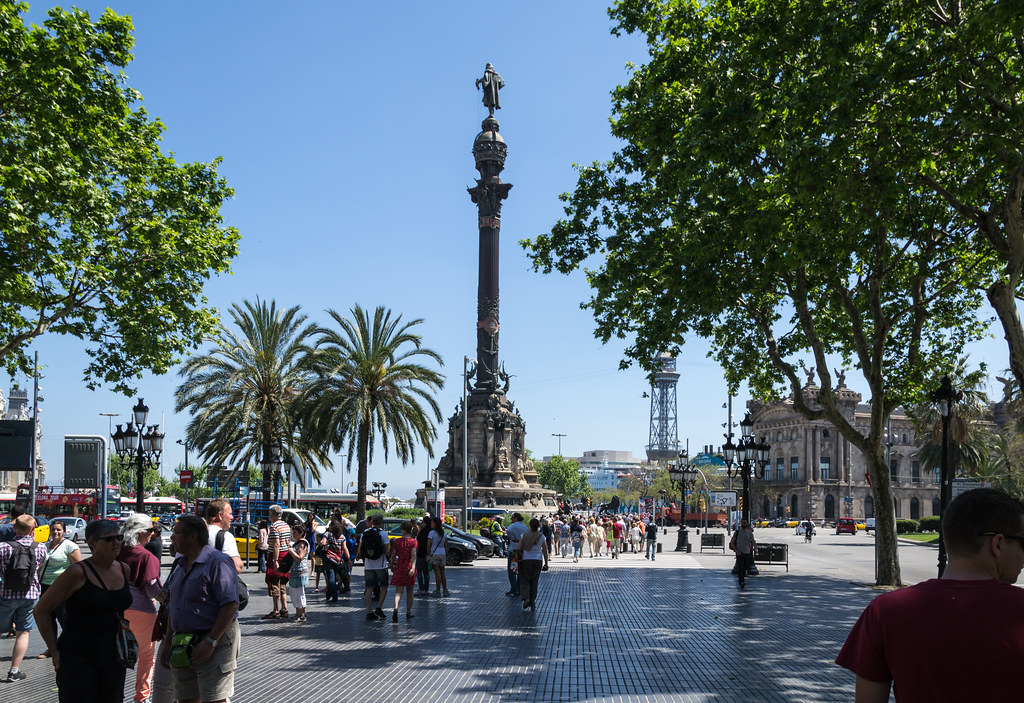
Travel: la Rambla, Barcelona
It is hard to be in Barcelona and not be slack-jawed.
There is so much life, living, and vibrant splendour all around. In ways small and large, Spain’s vital port city stands as a tribute to beauty. The blood-red geraniums that spill over ceramic containers from tiny balconies; the plazas with their statues and cafes; Antonio Gaudi’s dream/nightmare, La Sagrada Familia, soaring high over the construction equipment that surrounds it; the Gothic Quarter with its stone walls and quaint shops; the Picasso Museum housing the Master’s early works; and, in the distance, Montserrat, the jagged mountain looking down like some sort of benediction.
It’s the La Rambla, however, that is the beating heart of Barcelona. And what an exciting heartbeat! The long, wide, tree-lined avenue is quite easily the most exhilarating one I have seen; Piccadilly, St Mark’s Square and the Champs Elysees notwithstanding. Hedged by plane trees, the mile-long road is packed with people, day and night…even during siesta!
Within minutes of arriving, I felt at home, sort of. In search of a battery for my Nikon, I wandered into Nath’s, just off the avenue. Old Mr. Nath was explaining something in perfect Spanish (or maybe Catalan, for all I know) to a local, so his son tried to solve my camera problem. Soon the young man ditched his English for Hindi. “Go to the head of La Rambla,” he advised me, naming a well-known departmental store.

Thrumming with energy
Which was how I came to the Placa de Cataluñya, only to forget about batteries, cameras and suchlike; I stopped to stare, instead.
The square — with its fountains spilling over with water, statues of divinely proportioned demigods and damsels, people walking to and fro or sitting under striped awnings enjoying a café con leche — is such a lovely place. Bus, trains and Metro routes converge here; protests and demonstrations concentrate themselves here; big departmental stores like El Corte Ingles, Marks and Spencer’s and El Triangle hem the square in.
In medieval times, this area was Barcelona’s western border, walled and lined with fortress-like buildings. The statues of half-clothed women were deemed immoral when they were first unveiled in the 1920s. Today, almost all of Barcelona passes them with nary a glance.
Soaked in history, La Rambla — once a river bed — has been called ‘a metaphor for life’; the great Spanish poet Lorca said it was “the only street in the world which I wish would never end”. What’s more, the locals have taken full ownership of the boulevard. They have a word for it in Spanish: ramblejar, as in strolling down the La Rambla.

Pedestrian heaven
On this promenade, the stroller reigns supreme. La Rambla is for pedestrians. Over a kilometre long, it is split into five distinct sections. The seaward end with the monument to Columbus is a good place to start your walk, passing the Rambla de Santa Monica, formerly a convent, now an Arts Centre. Then move past the portrait painters where even the most jaded palate just has to stop and grin at the quick but creative impressions of celebs, politicians and ordinary plebs. After which, the same jaded palate may just cough up a few Euros for a quick charcoal sketch of him/herself. I will admit I did, my palate being far from jaded!
Next up is the grand frontage of the Teatre Principal, then the mosaic-fronted Ramblas Hotel where Papa Hemingway, Lorca and other greats have stayed. Hardly does one pause to admire these pieces of the past when one is assailed by the next bit of excitement the boulevard had to offer: the magicians, buskers and Barcelona’s famed living statues.
The last lot are performance artistes who are spray-painted and make living but preternaturally still statues of Dracula, Roman gladiators, headless ghosts, and the like. Next is the Café de la Opera, which is almost always crowded with people eating, drinking and arguing.
Up next is La Boqueria, Barcelona’s main market, housed in a steel-girder cage, a must-see: fruit and vegetable stalls jostle with seafood, cheese, olives, wild mushrooms — all of it an epicurean’s delight. The market is near the Rambla de les Flors; on this stretch, flower stalls line the promenade, giving off a heady fragrance.
Next to them are the newspaper vendors; here you will find vintage porn, too, like the bouquinistes of Paris. So be prepared to quickly don impassive expressions when you pick up what you think is a copy of Neruda and find it is actually turn-of-the-last-century pornography.
Along with lyrical descriptions and paeans of praise about La Rambla come dire warnings, too. This is supposed to be Pickpocket Central, the place of old veterans and older ruses, like ink sprayed onto the unsuspecting stroller`’s clothes to distract him or her while the pickpocket does his job.
One is told not to lock eyes with suspicious characters, not to give out the time or answer questions from seedy individuals but then one also hears of perfectly executed con jobs by well-dressed and well-spoken ladies and gentlemen! Ah well, c’est la vie.

Slice of life
What no one tells you till you are actually at La Rambla is about the nude gentlemen.
These are a couple of mavericks who take off all their clothes and go strolling down the avenue, with a smile on their face and nary a care in the world! Tourists jostle to take their pictures but they don’t blink. These men don’t follow any particular timetable but I spotted them mid-morning one day and late at night the next.
Most of the stalls on La Rambla sell your average touristy souvenirs and football shirts. La Bouqueria, though, is the place to go for local pastries and cakes, as well as a formidable collection of cheeses.
Behind the trees, for those who care to look, stand stately buildings like the Palau de la Virreina, an exhibition centre now, the Betlem church, the Rambla dels Estudis. And in front, the last stretch of the Rambla holds pet stalls teeming with interested onlookers and would-be buyers looking at fish, turtles, small birds and guinea pigs.
And, finally, one comes to the small fountain at the Rambla de Canaletes with its metal chairs; this is where football fans and fiends gather to indulge in passionate and endless discussions of the game. The legend goes that whoever drinks from this fountain is sure to return to Barcelona.
Needless to say, I and just about everyone walking along La Rambla that day, drank from the fountain.

Y viva La Rambla!
But oh, I never did find a replacement battery for my camera. The walk down La Rambla drove all thoughts of it from my mind.
This ran in THE HINDU of 15 Aug 2010.
Related Links:
Travel: The Mesquita in Cordoba, Spain
TRAVEL: THE NEW INDIAN EXPRESS/GRANADA`S GYPSIES, SPAIN
Feature: Walking a virtual Camino
